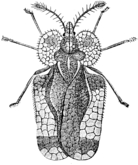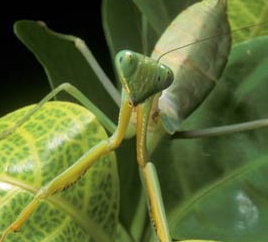

| SPRING 2004 CONTENTS |
|
| BUGS at the Louisville Science Center |

|
|
BUGS
AT THE LOUISVILLE SCIENCE CENTER |
|
| This summer, the Louisville Science Center is presenting BACKYARD MONSTERS, an exhibit devoted to insects and their relatives. Featuring giant robotic arthropods and a large collection of mounted insects, this exhibit will be THE place to introduce Kentucky students to entomology. EDUCATION OPORTUNITIES: Backyard Monsters is designed with teachers in mind. At the Louisville Science Center's web site, you can download an activity guide that complements the exhibit. The activity guide is divided by grade and includes information that explains the exhibit in detail. If you take your students, be sure to bring the activity guide!
|
 The Green Mantid, an insect featured in the IMAX movie, A Rainforest Adventure, Bugs! (Photo by Chris Parks) |
| |
MAXIMUM INSECTS: In conjunction with the Backyard Monsters exhibit, the IMAX Theater at the Louisville Science Center will be showing A Rainforest Adventure - BUGS!, a movie that shows (in giant detail!) the lifecycles of two tropical insect species, a praying mantid and a butterfly. If you've never seen an IMAX movie, you will be in for a surprise. IMAX movies are shown on huge screens that take advantage of your "eyes" to the "max." Can you imagine insects that are 30-feet high, coming at you from all angles? To learn more about A Rainforest Adventure - Bugs!, visit the web site at www.giantscreenbugs.com. For more information about Backyard Monsters or A Rainforest Adventure, visit the Backyard Monsters page at the Louisville Science Center's web site. If you are planning to bring a group of students, visit their Tour Groups page to learn about group discounts. |
|
SUMMER WORKSHOPS |
| There will be two training opportunities in Summer, 2004 for Kentucky teachers who want to learn more about insects and how to use them in the classroom. | |
| July 6-7, 2004
- Entomology: Down On The Farm |
|
| July
26-30, 2004 - Watersheds of the Salt River Basin |
|
CRITTER OF THE MONTH: ORB-WEAVER
SPIDERS |
||
|
Like all spiders, orb-weavers have eight legs and two body parts (cephalothorax and abdomen). Orb-weavers have large, spherical abdomens and look very much like cobweb spiders, but cobweb spiders do not build orb webs. In fact, most web-building spiders do not build orb webs. Orb-weaver spiders and long-jawed orb-weavers are the only common Kentucky spiders that build orb-webs. Read more about Orb-Weavers in the Critter Case Files. |
||
| Critter Of The Month is a new Wee Beasties feature. Each month, we will feature one of the critters from the Critter Case Files, University of Kentucky's on-line field guide to insects, spiders, and related critters. | ||
|
BOOKS |
||
|
|
UPCOMING EVENTS |
||||||||||||
| The Entomology Department
will be present with displays, insects, and information at the following
events and locations during the upcoming months in 2004:
|
||||||||||||
|
WEE BEASTIES MAILING LIST |
|||
|
|||
|
CONTACT INFORMATION |
| If you have ideas, experiences,
or information that you would like to share or would like information
about educational resources available through the University of Kentucky,
Department of Entomology, write, phone, or email: Blake
Newton View and print Wee Beasties in the Adobe Acrobat (tm) PDF format. The Adobe Acrobat (TM) PDF format allows you to download, view, search, and print, while maintaining the original printed look of the document. You will need the (free) Adobe Acrobat Reader plug-in to read PDF documents.
Black and white
images used with permission from http://www.arttoday.com
Educational
Programs of the Cooperative Extension Service serve all people regardless
of race, color, age, sex, religion, disability, or national origin.
UNIVERSITY OF KENTUCKY, KENTUCKY STATE UNIVERSITY, DEPARTMENT OF AGRICULTURE AND KENTUCKY COUNTIES COOPERATING. |